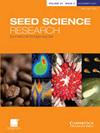两个居群的种子萌发响应差异一组GR24的浓度和刺激持续时间
IF 1.9
3区 生物学
Q2 PLANT SCIENCES
引用次数: 1
摘要
摘要雷莫沙Phelipanche ramosa是一种主要的杂草全寄生生物,其特征是宿主范围广,在许多宿主上发育不理想,这表明了种间或种内的特异性。ramosa的种子在暴露于宿主周围根系分泌的外源化学物质(如三果内酯)后发芽,这些发芽刺激剂的浓度因宿主而异。在法国,ramosa的特征是遗传分化的种群表现出不同的发芽率和宿主特异性。我们研究的目的是研究在烟草和油菜上收获的两个P.ramosa种群的种子对一组GR24浓度(一种合成的strigol类似物)的敏感性。发芽率的评估是基于体外实验。将ramosa的种子放入具有不同浓度GR24的培养皿中。在施用该处理后,对红梅的发芽种子的累积数量进行多次计数。使用三参数对数逻辑模型和时间-事件方法分析累积发芽曲线。结果表明,ramosa种子的发芽率取决于GR24的浓度和刺激的持续时间,但对这两个因素的反应也因其种子的来源而异。ramosa种群之间发芽速度的差异在种内水平上进一步显示出不同的反应,因此表明ramosa的特化可能至少从全寄生虫周期的第一阶段开始发生。本文章由计算机程序翻译,如有差异,请以英文原文为准。
Differences in seed germination response of two populations of Phelipanche ramosa (L.) Pomel to a set of GR24 concentrations and durations of stimulation
Abstract Phelipanche ramosa is a major weed holoparasite characterized by a broad host range with a suboptimal development on numerous hosts, suggesting inter- or intra-species specificities. Seeds of P. ramosa germinate after exposure to exogenous chemicals exuded by surrounding host roots such as strigolactones, the concentrations of these germination stimulants varying between hosts. In France, P. ramosa is characterized by genetically differentiated populations presenting varying germination rates and a host specificity. The objective of our study was to investigate the sensitivity of seeds of two P. ramosa populations harvested on tobacco and oilseed rape, to a set of GR24 concentrations, a synthetic strigol analogue. The assessment of the germination rate was based on in vitro experiments. Seeds of P. ramosa were placed in Petri dishes with various concentrations of GR24. The cumulative number of germinated seeds of P. ramosa was counted several times after application of the treatment. Cumulative germination curves were analysed using a three-parameter log-logistic model and a time-to-event approach. The results show that the germination rate of P. ramosa seeds depends on the GR24 concentration and the duration of stimulation, but also that the response to these two factors varies greatly according to the origin of the P. ramosa seeds. The difference in germination speed between P. ramosa populations further shows distinct responses at the intraspecific level, thus suggesting that the specialization of P. ramosa probably occurs at least from the first stage of the holoparasite cycle.
求助全文
通过发布文献求助,成功后即可免费获取论文全文。
去求助
来源期刊

Seed Science Research
生物-植物科学
CiteScore
3.60
自引率
4.80%
发文量
23
审稿时长
>12 weeks
期刊介绍:
Seed Science Research, the official journal of the International Society for Seed Science, is a leading international journal featuring high-quality original papers and review articles on the fundamental aspects of seed science, reviewed by internationally distinguished editors. The emphasis is on the physiology, biochemistry, molecular biology and ecology of seeds.
 求助内容:
求助内容: 应助结果提醒方式:
应助结果提醒方式:


